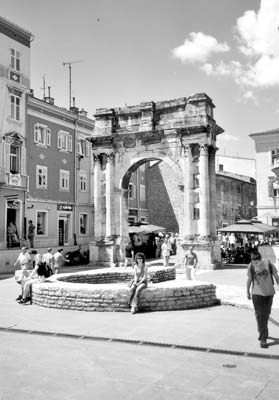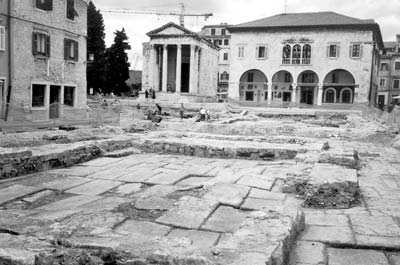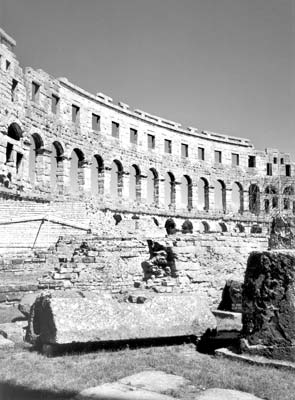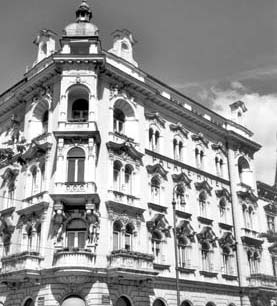Focus on Archaeology — Pula, a Roman treasure in Croatia
by Julie Skurdenis
“You’ve come at just the right time,” commented the cheerful young woman in the Tourist Information Office. “If you look just outside our front door, you’ll see the archaeologists excavating the Roman Forum. They just started six weeks ago.”
My husband, Paul, and I were in the Croatian town of Pula at the tip of the Istrian Peninsula jutting into the Adriatic. And, sure enough, what we had thought was just another street-repaving project was actually a sizeable portion of the Roman Forum’s pavement, around which were centered the town’s most important public buildings and temples 2,000 years ago.
Three important temples once stood here. One still does: the Temple of Augustus, built between 2 B.C. and A.D. 14, destroyed by a direct bomb hit in World War II and reconstructed after the war. It resembles the Maison Carrée in Nimes, France.
Of the other two temples, one has completely disappeared and the other, the Temple of Diana, has portions incorporated into the back of the 13th-century Town Hall, adjacent to the Temple of Augustus.
The Istrian Peninsula in the extreme northwestern corner of Croatia was settled by an Illyrian tribe 3,000 years ago. Pula (Illyrian Pola) was one of their fortified hill towns. The Romans conquered Pola in the first century B.C., building temples, arches, a theater, villas, an arena and this forum at the base of the small hill that had been the Illyrian stronghold. Much of what they built can still be seen.
Arch of Sergius
The street, Ulica Sergijevaca, curves in a semicircle through what used to be Roman Pula past a mix of houses from many eras — medieval, Renaissance, 18th and 19th centuries, modern — to the Triumphal Arch of Sergius, erected in 27 B.C. to commemorate three members of the Sergius family. One side is ornamented with columns and fragments of winged victories that resemble angels; the other side — once backed by a city gate — is plain but imposing nonetheless.
Beyond the arch are remnants of Roman walls, and behind them, the apricot-colored building where the young James Joyce lived with his runaway bride early in the last century, earning his keep as a teacher.
There are lots of cafés here where locals gather and where weary tourists can rest over a cup of cappuccino. Just beyond on the left are twin gates built by the Romans in the second century A.D., once part of the dozen city gates leading into the ancient city. The melange of architectural remnants lying just beyond the gate in a seemingly haphazard jumble belong to the adjacent Archaeology Museum. Behind the museum up a short steep hill lies a small Roman theater.
Roman Arena
Five minutes from the museum, away from the street encircling the hill, lies the Arena, the crème de la crème of Pula and the magnet drawing most tourists to this city. It is magnificent.
Lying just outside the Roman city walls, it was begun in the reign of Augustus at about the same time as the Temple of Augustus and completed in the second half of the first century A.D. by Emperor Vespasian, whose lady friend supposedly came from Pula (hence his putting money into a project begun by a predecessor).
Remarkably, the 100-foot-high outer wall remains almost intact, with four towers that provided access to the upper tiers, plus two rows of 72 arches. Along the top ran a gutter, still visible, to channel rainwater. Twenty-thousand spectators could gather here to watch gladiatorial contests — man vs. beast, man vs. man, beast vs. beast — protected from the rain by a fabric canopy stretched across the entire Arena (you can still see where these were secured).
There are no longer any spectator stone seats left. These were all cannibalized in the Middle Ages and after for other building projects, including the Cathedral’s bell tower. Wooden seats are now erected for summer concert spectators.
The Cathedral was closed for a long 4-hour lunch during our visit. We would have liked to have seen the third-century-A.D. Roman sarcophagus used as an altar and the fifth/sixth-century-A.D. mosaic fragments that form part of its floor. Next time.
If you want to see the ongoing archaeological work at the Forum, go soon. According to the tourist office, town officials don’t yet know whether the Forum will remain open to view or will be covered up again because of a lack of funds for maintenance.
Seaside Lovran
Pula was an excursion we made from Lovran, a lovely seaside town in the northeastern part of the Istrian Peninsula. Lovran has a tiny gem of an Old Town centered on a plaza with a small church, a restaurant for dining (alfresco, preferably), a café for cappuccino or Croatian wine (alfresco, again), and ancient houses with peeling paint.
If you visit, look for the cat that sits nightly in the window over the souvenir shop near the café and the little dog that sits nightly in the window of the house on the opposite side. They stare at each other for hours, probably wondering if they’ll ever meet in person.
Other Croatian towns we stayed in were Dubrovnik, with its marble main street (Placa, also called Stradun) and Old Town filled with palaces and churches, now a UNESCO World Heritage Site; Split, with Diocletian’s enormous palace built between A.D. 295 and 305, also a World Heritage Site, and Zagreb, with its old-world, elegant Lower Town, medieval Upper Town and an Archaeology Museum with a fabulous small Egyptian collection. There’s even a café in its garden where you can sip cappuccino while sitting among 2,000-year-old tombs.
If you go. . .
We traveled with Overseas Adventure Travel (124 Mount Auburn St., Ste. 200 North, Cambridge, MA 02138; call 800/221-0814 or visit www.oattravel.com) on a 14-day trip in June ’06 that included Slovenia, Bosnia & Herzegovina and Montenegro as well as Croatia.
We paid $3,570 each, and this included accommodations, most meals, tours, transportation and airfare from New York; OAT includes airfare in its tours.
What we liked best about OAT was the smallness of its groups (ours had 14) and the amount of “free time” for individual exploration.
We flew Lufthansa to Germany and then Croatia Air (800/645-3880) to Zagreb. We were upgraded to business class on the flight to Frankfurt and were delighted to find fully reclining seats that became flat beds. But the food served aloft was so good, we kept on eating and almost forgot to nap. ITN




